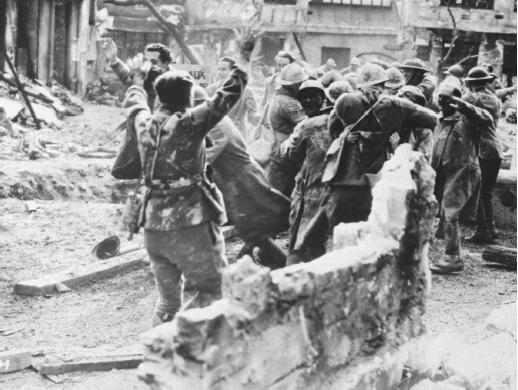J'ACCUSE - Film (Movie) Plot and Review
France, 1919
Director: Abel Gance
Production: Charles Pathé (major investor); black and white, 35mm, silent; length: 1500 meters. Released 1919. Cost: about 456,000 francs.
Scenario (at least in part): Abel Gance; photography: L. H. Burel, Bujord, and Forster; editor: André Danis; assistant director: Blaise Cendrars.
Cast: Séberin Mars ( François Lauron ); Romuald Joubé ( Jean Diaz ); Maryse Dauvray ( Edith ); Desjardins; Blaise Cendrars.
Publications
Script:
Gance, Abel, J'accuse , Paris, 1922.
Books:
Daria, Sophie, Abel Gance, hier et demain , Paris, 1922.
Icart, Roger, Abel Gance , Toulouse, 1960.
Brownlow, Kevin, The Parade's Gone By , London and New York, 1969.
Sadoul, Georges, French Film , New York, 1972.
Monaco, Paul, Cinema and Society: France and Germany during the 20s , New York, 1976.
Kramer, Steven, and James Welsh, Abel Gance , Boston, 1978.
Icart, Roger, Abel Gance; ou, Le Promethée foudroyé , Lausanne, 1983.
King, Norman, Abel Gance: A Politics of Spectacle , London, 1984.
Groppali, Enrico, Abel Gance , Florence, 1986.
Articles:
Kine Weekly (London), 29 April 1920.
Bioscope (London), 29 April 1920.
New York Times , 10 October 1921.
Variety (New York), 14 October 1921.
Esnault, Philippe, "Filmographie d'Abel Gance," in Cahiers du Cinéma (Paris), January 1955.
"Gance Issue" of Ecran (Paris), April-May 1958.
Brownlow, Kevin, "Abel Gance: Spark of Genius," in Films and Filming (London), November 1969.
Lenning, Arthur, "The French Film—Abel Gance," in The Silent Voice: A Text (New York), 1969.
"Film as Incantation: An Interview with Abel Gance," in Film Comment (New York), March-April 1974.
Kramer, Steven, and James Welsh, "Abel Gance's Accusation against War," in Cinema Joursenal (Evanston, Illinois), Spring 1975.
Debacker, J., "Dossier: La Censure, Monsieur J. Brunin: J'Accuse ," in Apec-Revue Belge du Cinéma (Brussels), no. 4, 1976.
Brownlow, Kevin, "Abel Gance," in Film Dope (London), September 1979.
Cluny, C. M., "Abel Gance: Trop grand pour le cinéma?," in Cinéma (Paris), December 1981.
King, Noel, "The Sound of Silents," in Screen (Oxford), vol. 25, no. 3, May-June 1984.
Veray, L., " J'accuse: un film conforme aux aspirations de Charles Pathe et a l'air de temps," in 1895 , no. 21, December 1996.
* * *
Abel Gance was one of the most innovative filmmakers of the silent era. Most famously, in his masterpiece Napoleon , he projected three images on screen at once in a process he called Polyvision. But this film is not Gance's only epic. Eight years before Napoleon , there was J'accuse .
While Napoleon celebrates the exploits of its title character, J'accuse is unabashedly anti-military. The setting is a small French town. A gentle poet, who opposes war and all hostility, loves the wife of a hunter. War is declared, and the husband goes off to fight; jealous of his rival, he dispatches his wife to the Ardennes. When she is captured by the Germans, the poet himself enlists. By the finale, the hunter has been killed in battle, the wife is raped, and the poet, driven mad by the destruction that has destroyed his life, drops dead. While he does not die in combat, his demise—and the tainting of his spirit, his zest for life, his inner peace and love of beauty—becomes the symbol of the pointlessness of war.
J'accuse is one of the earliest cinematic indictments of war. This fact alone earns the film its status in film history. But, additionally, it is one of the first French films to use montage and superimposed shots. In a stunning series of images, closeups of hands grasp each other, pray and raise glasses of wine as soldiers leave to fight. Gance communicates with his audience with visual metaphors: at the film's outset, the head of a dog is placed over the head of the hunter and, at the declaration of war, the Grim Reaper is placed over the poet's work; the filmmaker's rapid montage cutting highlights the horror of the battle sequences, shot by Gance after joining a French army unit. (He perfected this last technique in La Roue , a melodrama released in 1923, and in Napoleon .) The most famous sequence in J'accuse

J'accuse was, upon its release, condemned for its anti-war sentiment by those basking in the German defeat. Gance wanted to make two sequels, to be called The Scars (Les cicatrices) and The League of Nations (La Société des Nations ). Although these films were never completed, he did revise J'accuse four years after its release, most notably comparing the return of the dead soldiers sequence with a victory celebration.
Gance remade J'accuse with sound in 1937. He wrote that this new version was "intended as a challenge to the countries of Europe for permitting the gradual development of a situation that made war inevitable. Before the present menace became a reality, I wrote an introduction to the film which expresses the prophetic message it conveys from the screen: 'This film is dedicated to those who will die in the new war of tomorrow, although I am sure that they will view it skeptically and will fail to recognize themselves in it. . . ."'
Unfortunately, like Renoir's Grande illusion, J'accuse had no effect on altering the events which resulted in the next Great War.
—Rob Edelman
Comment about this article, ask questions, or add new information about this topic: